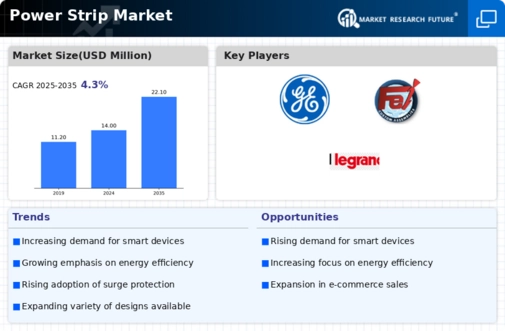Top Industry Leaders in the Power Strip Market
*Disclaimer: List of key companies in no particular order
Top listed global companies in the Power Strip industry are:
ABB Ltd, (Switzerland)
Siemens AG (Munich)
Schneider Electric SE (Paris)
Delixi Electric Ltd (China)
General Electric (US)
Belkin International Inc. (US)
Falconer Electronics (US)
Panasonic Corporation (Japan)
Legrand SA (France)
Cyber Power Systems Inc. (US)
Bridging the Gap by Exploring the Competitive Landscape of the Power Strip Top Players
The power strip market, often perceived as a simple, unassuming segment, pulsates with a dynamic competitive landscape. While the core functionality remains constant – providing additional outlets – the fight for market share is a complex interplay of established giants, nimble innovators, and regional players. Understanding the strategies adopted by key players, the evolving market dynamics, and emerging trends is crucial for navigating this electrifying terrain.
Key Player Strategies: Differentiation in a Crowded Field
Brand Recognition: Legacy players like Belkin, Tripp Lite, and APC Leverage their established brand reputation to command premium pricing and secure shelf space in major retailers.
Innovation: Companies like APC and CyberPower are pushing boundaries with surge protection, smart home integration, and energy-saving features, catering to tech-savvy consumers.
Cost Leadership: Asian manufacturers like Gembird and Lecon offer competitive pricing through efficient production and lower overheads, targeting budget-conscious buyers.
Niche Specialization: Brands like Brennenstuhl and Monster cater to specific segments like audiophiles or professionals, offering premium materials, enhanced safety features, and targeted marketing.
Direct-to-Consumer: Online brands like Anker and Aukey are disrupting traditional distribution channels, offering competitive pricing and rapid product iterations through online platforms.
Market Share Analysis: Beyond Numbers
Analyzing market share in the power strip market requires a nuanced approach. While traditional metrics like revenue and unit volume provide a baseline, deeper factors paint a more accurate picture:
Product Mix: Companies with diverse offerings across price points and features cater to a wider audience, gaining an edge over those with limited portfolios.
Regional Strength: Regional players may dominate specific markets due to cultural preferences, distribution networks, and lower production costs.
Channel Expertise: Brands with strong relationships with retailers, e-commerce platforms, or DIY stores have better market penetration than those solely reliant on direct sales.
Brand Loyalty: Established players with loyal customer bases retain market share even when facing price competition from newer entrants.
New and Emerging Trends: Powering the Future
The power strip market is witnessing a surge in innovation, driven by consumer preferences and technological advancements:
Smart Homes: Integration with smart home ecosystems like Amazon Alexa and Google Home is becoming a key differentiator, enabling voice-controlled power management.
Sustainable Solutions: Energy-saving features like surge protection with auto-off and smart plugs that monitor power consumption are gaining traction among eco-conscious consumers.
Safety and Security: Advanced surge protection technologies, tamper-proof outlets, and child safety features are becoming increasingly important, especially for families and commercial spaces.
Customization: Modular power strips with interchangeable outlets and charging ports cater to individual needs and preferences.
Wireless Charging: Integration of wireless charging pads into power strips is creating a new hybrid market segment for mobile-centric consumers.
Competitive Scenario: A Charged Atmosphere
The overall competitive landscape of the power strip market is characterized by:
Intense Price Competition: The presence of numerous players, both global and regional, keeps price pressure high, particularly in the basic segment.
Rapid Innovation: The focus on smart features, sustainability, and customization is driving rapid product development cycles and shorter product lifespans.
Consolidation and Acquisitions: The market is likely to see consolidation as larger players acquire smaller brands with unique technologies or niche expertise.
Focus on Emerging Markets: The growing demand for affordable power solutions in developing economies presents significant opportunities for manufacturers with cost-effective production strategies.
In conclusion, the power strip market, despite its seemingly simple nature, is a dynamic and competitive space. Understanding the key player strategies, market share dynamics, and emerging trends is crucial for navigating this electrifying landscape. Companies that adapt to changing consumer preferences, embrace innovation, and build strong brand loyalty are poised to plug into the future of this ever-evolving market.
Latest Company Updates:
ABB Ltd:
Dec 2023: Launched TerraMaxx portfolio of modular power strips with surge protection and energy monitoring capabilities. (Source: ABB press release)
Siemens AG:
Jan 2024: Announced partnership with Enphase Energy to develop smart home power management solutions, including integrated power strips. (Source: Siemens website)
Schneider Electric SE:
Oct 2023: Acquired APC, a leading provider of power strips and surge protectors, expanding its smart home product portfolio. (Source: Schneider Electric press release)
Delixi Electric Ltd:
Nov 2023: Unveiled a new line of energy-efficient power strips with USB charging ports at the Canton Fair. (Source: Yiwu Market News)
General Electric (GE):
Jan 2024: Discontinued its production of traditional power strips, focusing on smart home automation solutions. (Source: GE investor presentation)

